NHS Project Management: Models, Stakeholders, and Lifecycle Phases
VerifiedAdded on 2022/10/04
|7
|1872
|16
Report
AI Summary
This report provides an overview of project management strategies applicable to large-scale projects like those within the NHS, emphasizing the importance of careful initiation, planning, and execution. It discusses various project management models, including Benefits Realization Management (BRM) and the Theory of Constraints (TOC), highlighting their benefits in ensuring project success within limited resources. The report also underscores the significance of stakeholder engagement and the use of Project Initiation Documents (PID) in guiding project direction. Furthermore, it details the critical phases of a project lifecycle, from initiation and planning to execution, monitoring, and closure, emphasizing the need for adaptability and continuous improvement. The report concludes by stressing the importance of IT infrastructure upgrades and staff training to support new project implementations within the NHS. Desklib offers this and many more solved assignments for students.
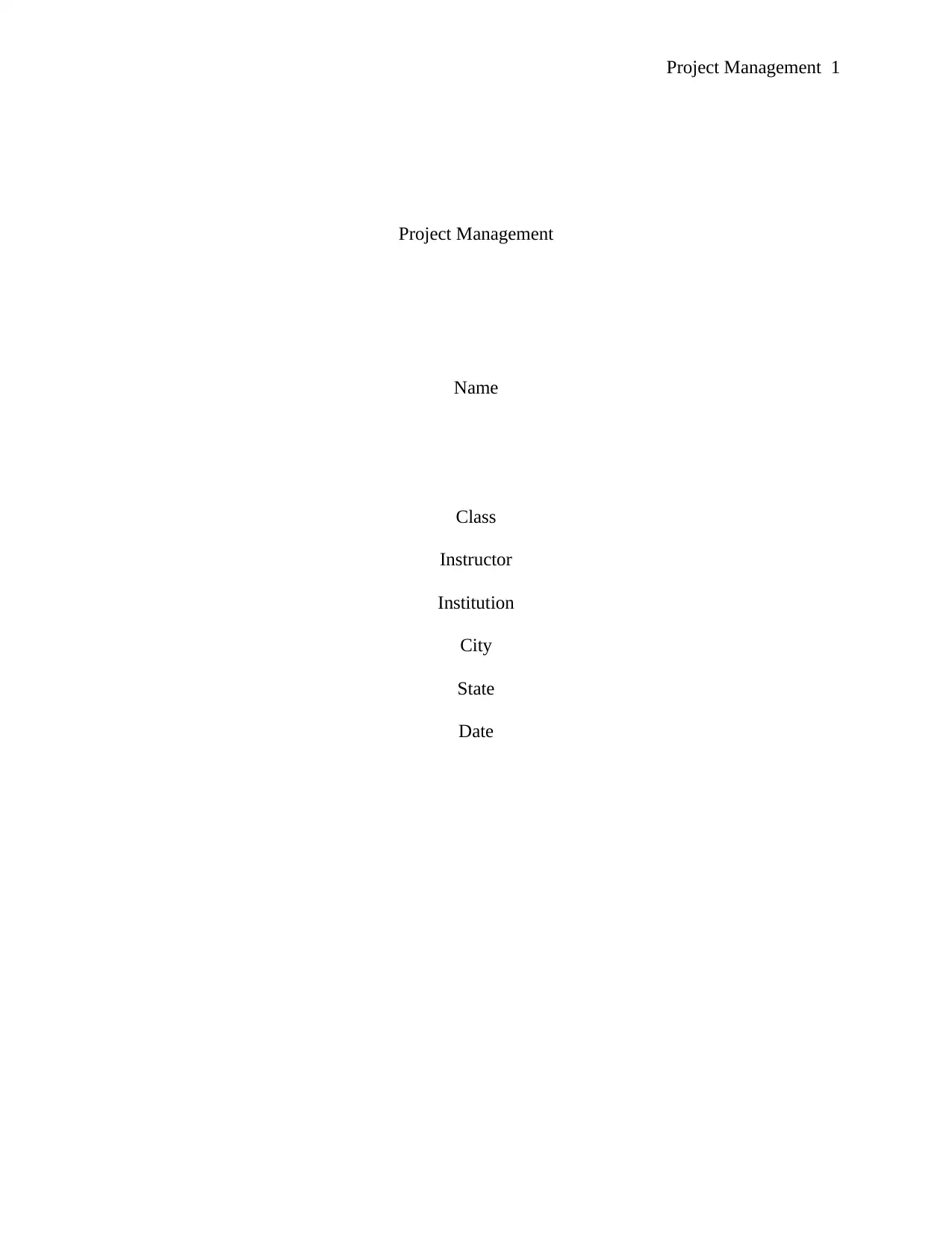
Project Management 1
Project Management
Name
Class
Instructor
Institution
City
State
Date
Project Management
Name
Class
Instructor
Institution
City
State
Date
Paraphrase This Document
Need a fresh take? Get an instant paraphrase of this document with our AI Paraphraser
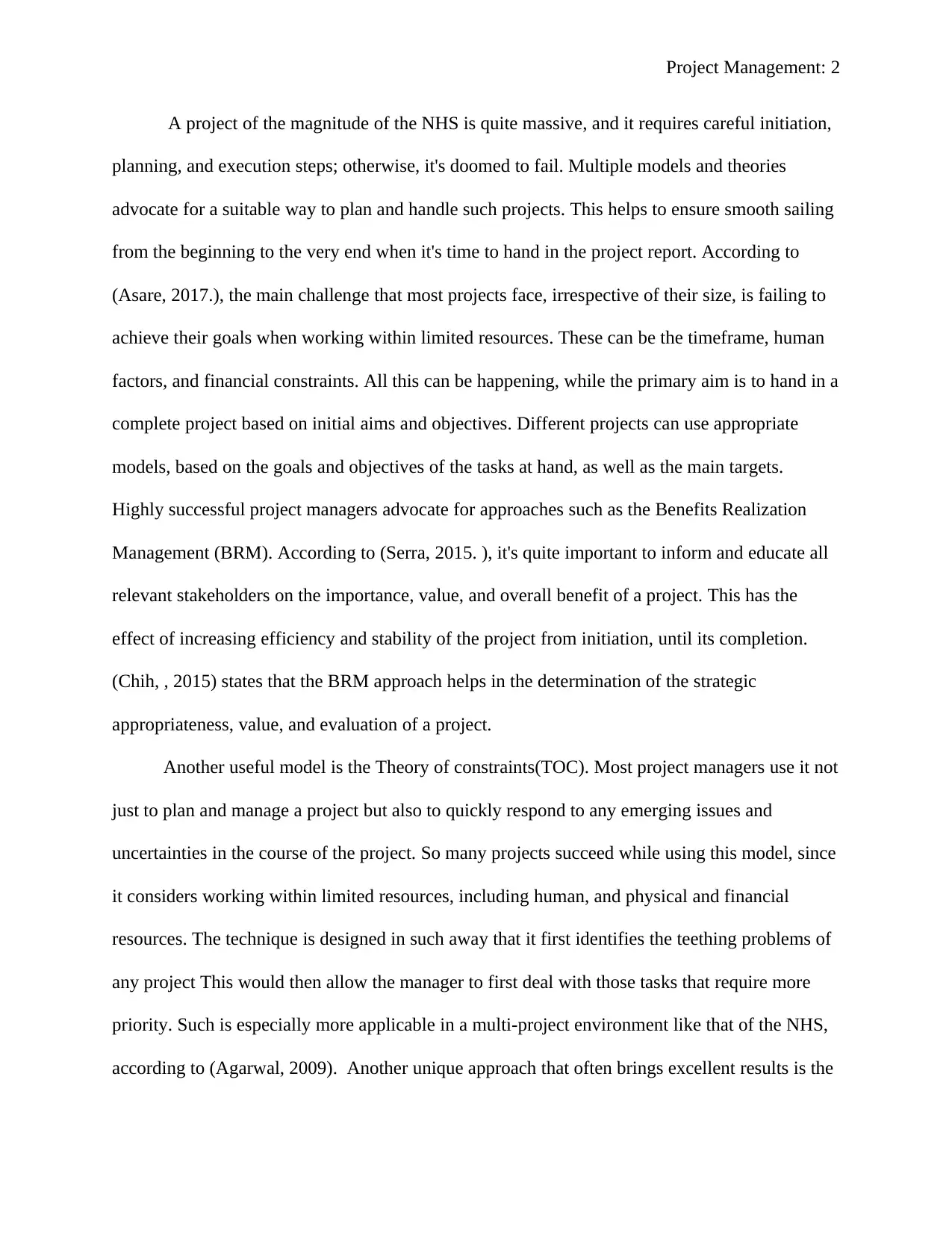
Project Management: 2
A project of the magnitude of the NHS is quite massive, and it requires careful initiation,
planning, and execution steps; otherwise, it's doomed to fail. Multiple models and theories
advocate for a suitable way to plan and handle such projects. This helps to ensure smooth sailing
from the beginning to the very end when it's time to hand in the project report. According to
(Asare, 2017.), the main challenge that most projects face, irrespective of their size, is failing to
achieve their goals when working within limited resources. These can be the timeframe, human
factors, and financial constraints. All this can be happening, while the primary aim is to hand in a
complete project based on initial aims and objectives. Different projects can use appropriate
models, based on the goals and objectives of the tasks at hand, as well as the main targets.
Highly successful project managers advocate for approaches such as the Benefits Realization
Management (BRM). According to (Serra, 2015. ), it's quite important to inform and educate all
relevant stakeholders on the importance, value, and overall benefit of a project. This has the
effect of increasing efficiency and stability of the project from initiation, until its completion.
(Chih, , 2015) states that the BRM approach helps in the determination of the strategic
appropriateness, value, and evaluation of a project.
Another useful model is the Theory of constraints(TOC). Most project managers use it not
just to plan and manage a project but also to quickly respond to any emerging issues and
uncertainties in the course of the project. So many projects succeed while using this model, since
it considers working within limited resources, including human, and physical and financial
resources. The technique is designed in such away that it first identifies the teething problems of
any project This would then allow the manager to first deal with those tasks that require more
priority. Such is especially more applicable in a multi-project environment like that of the NHS,
according to (Agarwal, 2009). Another unique approach that often brings excellent results is the
A project of the magnitude of the NHS is quite massive, and it requires careful initiation,
planning, and execution steps; otherwise, it's doomed to fail. Multiple models and theories
advocate for a suitable way to plan and handle such projects. This helps to ensure smooth sailing
from the beginning to the very end when it's time to hand in the project report. According to
(Asare, 2017.), the main challenge that most projects face, irrespective of their size, is failing to
achieve their goals when working within limited resources. These can be the timeframe, human
factors, and financial constraints. All this can be happening, while the primary aim is to hand in a
complete project based on initial aims and objectives. Different projects can use appropriate
models, based on the goals and objectives of the tasks at hand, as well as the main targets.
Highly successful project managers advocate for approaches such as the Benefits Realization
Management (BRM). According to (Serra, 2015. ), it's quite important to inform and educate all
relevant stakeholders on the importance, value, and overall benefit of a project. This has the
effect of increasing efficiency and stability of the project from initiation, until its completion.
(Chih, , 2015) states that the BRM approach helps in the determination of the strategic
appropriateness, value, and evaluation of a project.
Another useful model is the Theory of constraints(TOC). Most project managers use it not
just to plan and manage a project but also to quickly respond to any emerging issues and
uncertainties in the course of the project. So many projects succeed while using this model, since
it considers working within limited resources, including human, and physical and financial
resources. The technique is designed in such away that it first identifies the teething problems of
any project This would then allow the manager to first deal with those tasks that require more
priority. Such is especially more applicable in a multi-project environment like that of the NHS,
according to (Agarwal, 2009). Another unique approach that often brings excellent results is the
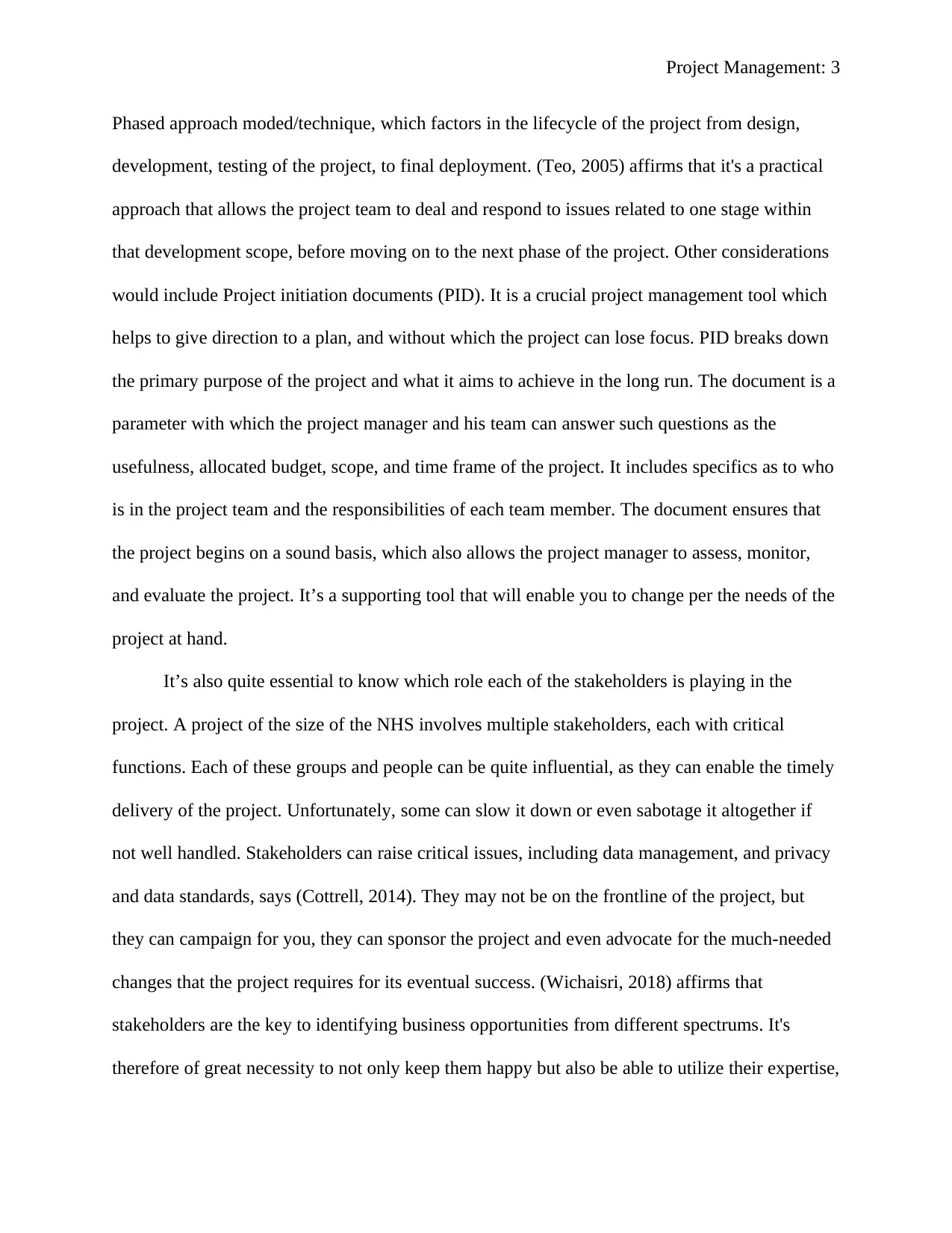
Project Management: 3
Phased approach moded/technique, which factors in the lifecycle of the project from design,
development, testing of the project, to final deployment. (Teo, 2005) affirms that it's a practical
approach that allows the project team to deal and respond to issues related to one stage within
that development scope, before moving on to the next phase of the project. Other considerations
would include Project initiation documents (PID). It is a crucial project management tool which
helps to give direction to a plan, and without which the project can lose focus. PID breaks down
the primary purpose of the project and what it aims to achieve in the long run. The document is a
parameter with which the project manager and his team can answer such questions as the
usefulness, allocated budget, scope, and time frame of the project. It includes specifics as to who
is in the project team and the responsibilities of each team member. The document ensures that
the project begins on a sound basis, which also allows the project manager to assess, monitor,
and evaluate the project. It’s a supporting tool that will enable you to change per the needs of the
project at hand.
It’s also quite essential to know which role each of the stakeholders is playing in the
project. A project of the size of the NHS involves multiple stakeholders, each with critical
functions. Each of these groups and people can be quite influential, as they can enable the timely
delivery of the project. Unfortunately, some can slow it down or even sabotage it altogether if
not well handled. Stakeholders can raise critical issues, including data management, and privacy
and data standards, says (Cottrell, 2014). They may not be on the frontline of the project, but
they can campaign for you, they can sponsor the project and even advocate for the much-needed
changes that the project requires for its eventual success. (Wichaisri, 2018) affirms that
stakeholders are the key to identifying business opportunities from different spectrums. It's
therefore of great necessity to not only keep them happy but also be able to utilize their expertise,
Phased approach moded/technique, which factors in the lifecycle of the project from design,
development, testing of the project, to final deployment. (Teo, 2005) affirms that it's a practical
approach that allows the project team to deal and respond to issues related to one stage within
that development scope, before moving on to the next phase of the project. Other considerations
would include Project initiation documents (PID). It is a crucial project management tool which
helps to give direction to a plan, and without which the project can lose focus. PID breaks down
the primary purpose of the project and what it aims to achieve in the long run. The document is a
parameter with which the project manager and his team can answer such questions as the
usefulness, allocated budget, scope, and time frame of the project. It includes specifics as to who
is in the project team and the responsibilities of each team member. The document ensures that
the project begins on a sound basis, which also allows the project manager to assess, monitor,
and evaluate the project. It’s a supporting tool that will enable you to change per the needs of the
project at hand.
It’s also quite essential to know which role each of the stakeholders is playing in the
project. A project of the size of the NHS involves multiple stakeholders, each with critical
functions. Each of these groups and people can be quite influential, as they can enable the timely
delivery of the project. Unfortunately, some can slow it down or even sabotage it altogether if
not well handled. Stakeholders can raise critical issues, including data management, and privacy
and data standards, says (Cottrell, 2014). They may not be on the frontline of the project, but
they can campaign for you, they can sponsor the project and even advocate for the much-needed
changes that the project requires for its eventual success. (Wichaisri, 2018) affirms that
stakeholders are the key to identifying business opportunities from different spectrums. It's
therefore of great necessity to not only keep them happy but also be able to utilize their expertise,
⊘ This is a preview!⊘
Do you want full access?
Subscribe today to unlock all pages.

Trusted by 1+ million students worldwide
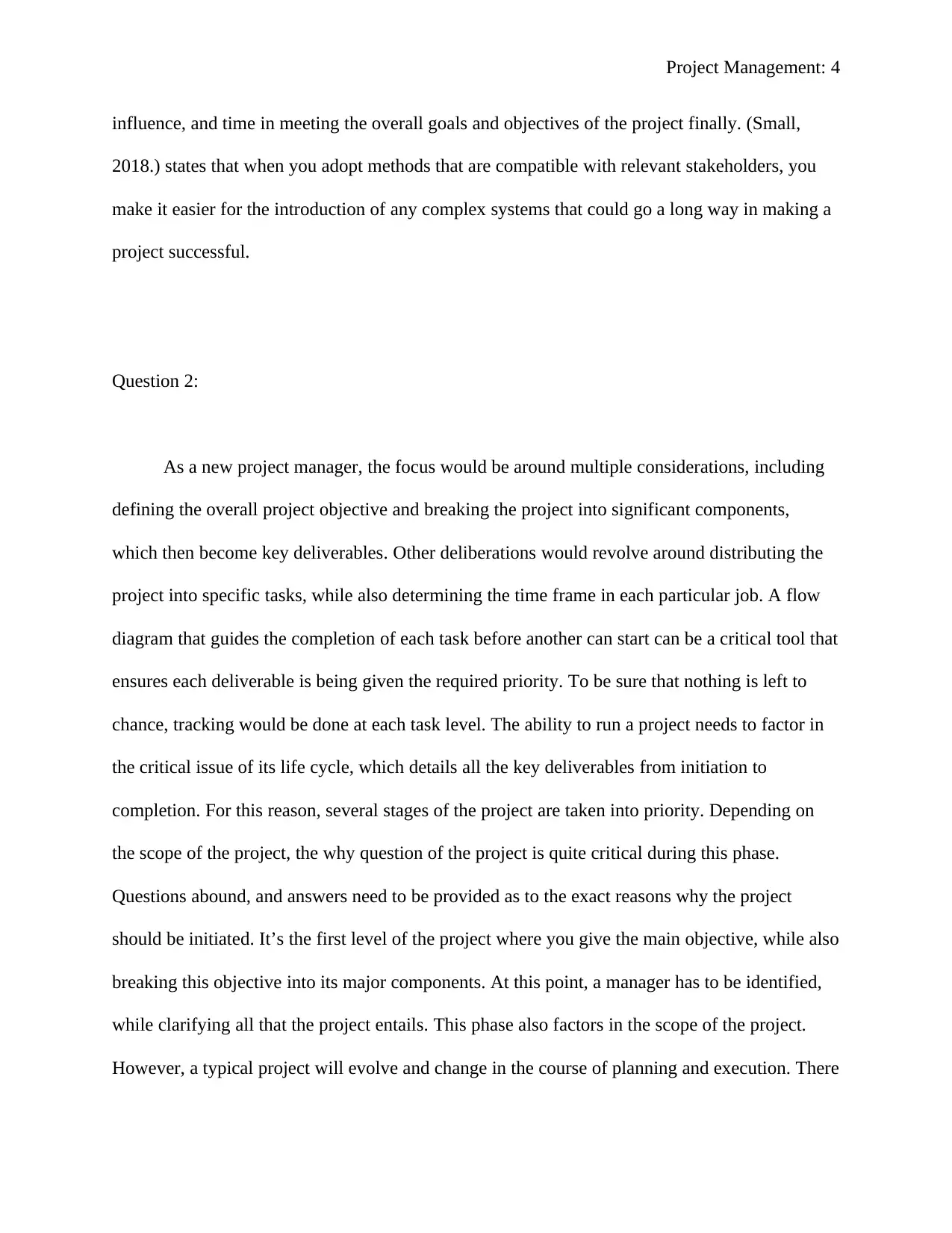
Project Management: 4
influence, and time in meeting the overall goals and objectives of the project finally. (Small,
2018.) states that when you adopt methods that are compatible with relevant stakeholders, you
make it easier for the introduction of any complex systems that could go a long way in making a
project successful.
Question 2:
As a new project manager, the focus would be around multiple considerations, including
defining the overall project objective and breaking the project into significant components,
which then become key deliverables. Other deliberations would revolve around distributing the
project into specific tasks, while also determining the time frame in each particular job. A flow
diagram that guides the completion of each task before another can start can be a critical tool that
ensures each deliverable is being given the required priority. To be sure that nothing is left to
chance, tracking would be done at each task level. The ability to run a project needs to factor in
the critical issue of its life cycle, which details all the key deliverables from initiation to
completion. For this reason, several stages of the project are taken into priority. Depending on
the scope of the project, the why question of the project is quite critical during this phase.
Questions abound, and answers need to be provided as to the exact reasons why the project
should be initiated. It’s the first level of the project where you give the main objective, while also
breaking this objective into its major components. At this point, a manager has to be identified,
while clarifying all that the project entails. This phase also factors in the scope of the project.
However, a typical project will evolve and change in the course of planning and execution. There
influence, and time in meeting the overall goals and objectives of the project finally. (Small,
2018.) states that when you adopt methods that are compatible with relevant stakeholders, you
make it easier for the introduction of any complex systems that could go a long way in making a
project successful.
Question 2:
As a new project manager, the focus would be around multiple considerations, including
defining the overall project objective and breaking the project into significant components,
which then become key deliverables. Other deliberations would revolve around distributing the
project into specific tasks, while also determining the time frame in each particular job. A flow
diagram that guides the completion of each task before another can start can be a critical tool that
ensures each deliverable is being given the required priority. To be sure that nothing is left to
chance, tracking would be done at each task level. The ability to run a project needs to factor in
the critical issue of its life cycle, which details all the key deliverables from initiation to
completion. For this reason, several stages of the project are taken into priority. Depending on
the scope of the project, the why question of the project is quite critical during this phase.
Questions abound, and answers need to be provided as to the exact reasons why the project
should be initiated. It’s the first level of the project where you give the main objective, while also
breaking this objective into its major components. At this point, a manager has to be identified,
while clarifying all that the project entails. This phase also factors in the scope of the project.
However, a typical project will evolve and change in the course of planning and execution. There
Paraphrase This Document
Need a fresh take? Get an instant paraphrase of this document with our AI Paraphraser
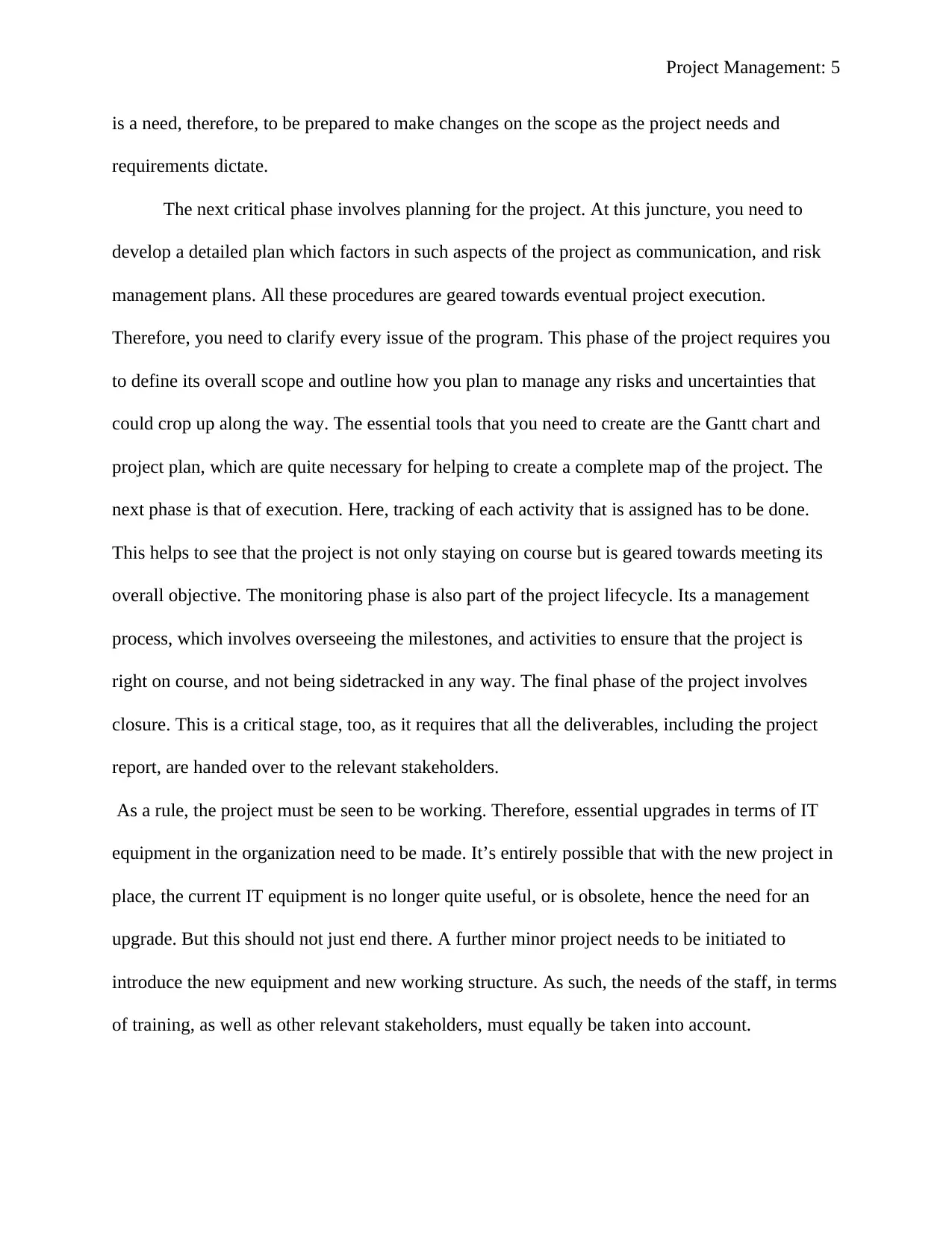
Project Management: 5
is a need, therefore, to be prepared to make changes on the scope as the project needs and
requirements dictate.
The next critical phase involves planning for the project. At this juncture, you need to
develop a detailed plan which factors in such aspects of the project as communication, and risk
management plans. All these procedures are geared towards eventual project execution.
Therefore, you need to clarify every issue of the program. This phase of the project requires you
to define its overall scope and outline how you plan to manage any risks and uncertainties that
could crop up along the way. The essential tools that you need to create are the Gantt chart and
project plan, which are quite necessary for helping to create a complete map of the project. The
next phase is that of execution. Here, tracking of each activity that is assigned has to be done.
This helps to see that the project is not only staying on course but is geared towards meeting its
overall objective. The monitoring phase is also part of the project lifecycle. Its a management
process, which involves overseeing the milestones, and activities to ensure that the project is
right on course, and not being sidetracked in any way. The final phase of the project involves
closure. This is a critical stage, too, as it requires that all the deliverables, including the project
report, are handed over to the relevant stakeholders.
As a rule, the project must be seen to be working. Therefore, essential upgrades in terms of IT
equipment in the organization need to be made. It’s entirely possible that with the new project in
place, the current IT equipment is no longer quite useful, or is obsolete, hence the need for an
upgrade. But this should not just end there. A further minor project needs to be initiated to
introduce the new equipment and new working structure. As such, the needs of the staff, in terms
of training, as well as other relevant stakeholders, must equally be taken into account.
is a need, therefore, to be prepared to make changes on the scope as the project needs and
requirements dictate.
The next critical phase involves planning for the project. At this juncture, you need to
develop a detailed plan which factors in such aspects of the project as communication, and risk
management plans. All these procedures are geared towards eventual project execution.
Therefore, you need to clarify every issue of the program. This phase of the project requires you
to define its overall scope and outline how you plan to manage any risks and uncertainties that
could crop up along the way. The essential tools that you need to create are the Gantt chart and
project plan, which are quite necessary for helping to create a complete map of the project. The
next phase is that of execution. Here, tracking of each activity that is assigned has to be done.
This helps to see that the project is not only staying on course but is geared towards meeting its
overall objective. The monitoring phase is also part of the project lifecycle. Its a management
process, which involves overseeing the milestones, and activities to ensure that the project is
right on course, and not being sidetracked in any way. The final phase of the project involves
closure. This is a critical stage, too, as it requires that all the deliverables, including the project
report, are handed over to the relevant stakeholders.
As a rule, the project must be seen to be working. Therefore, essential upgrades in terms of IT
equipment in the organization need to be made. It’s entirely possible that with the new project in
place, the current IT equipment is no longer quite useful, or is obsolete, hence the need for an
upgrade. But this should not just end there. A further minor project needs to be initiated to
introduce the new equipment and new working structure. As such, the needs of the staff, in terms
of training, as well as other relevant stakeholders, must equally be taken into account.
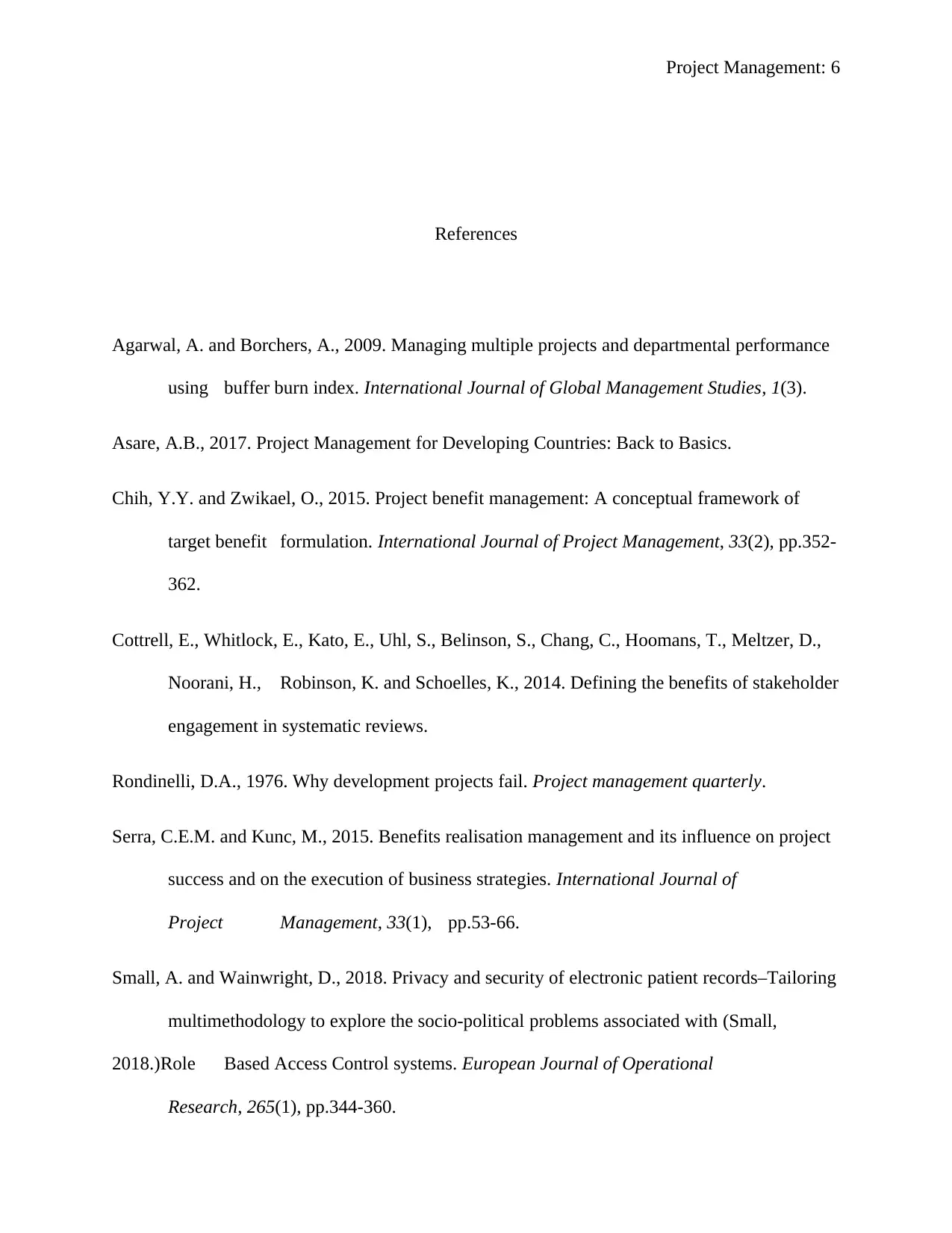
Project Management: 6
References
Agarwal, A. and Borchers, A., 2009. Managing multiple projects and departmental performance
using buffer burn index. International Journal of Global Management Studies, 1(3).
Asare, A.B., 2017. Project Management for Developing Countries: Back to Basics.
Chih, Y.Y. and Zwikael, O., 2015. Project benefit management: A conceptual framework of
target benefit formulation. International Journal of Project Management, 33(2), pp.352-
362.
Cottrell, E., Whitlock, E., Kato, E., Uhl, S., Belinson, S., Chang, C., Hoomans, T., Meltzer, D.,
Noorani, H., Robinson, K. and Schoelles, K., 2014. Defining the benefits of stakeholder
engagement in systematic reviews.
Rondinelli, D.A., 1976. Why development projects fail. Project management quarterly.
Serra, C.E.M. and Kunc, M., 2015. Benefits realisation management and its influence on project
success and on the execution of business strategies. International Journal of
Project Management, 33(1), pp.53-66.
Small, A. and Wainwright, D., 2018. Privacy and security of electronic patient records–Tailoring
multimethodology to explore the socio-political problems associated with (Small,
2018.)Role Based Access Control systems. European Journal of Operational
Research, 265(1), pp.344-360.
References
Agarwal, A. and Borchers, A., 2009. Managing multiple projects and departmental performance
using buffer burn index. International Journal of Global Management Studies, 1(3).
Asare, A.B., 2017. Project Management for Developing Countries: Back to Basics.
Chih, Y.Y. and Zwikael, O., 2015. Project benefit management: A conceptual framework of
target benefit formulation. International Journal of Project Management, 33(2), pp.352-
362.
Cottrell, E., Whitlock, E., Kato, E., Uhl, S., Belinson, S., Chang, C., Hoomans, T., Meltzer, D.,
Noorani, H., Robinson, K. and Schoelles, K., 2014. Defining the benefits of stakeholder
engagement in systematic reviews.
Rondinelli, D.A., 1976. Why development projects fail. Project management quarterly.
Serra, C.E.M. and Kunc, M., 2015. Benefits realisation management and its influence on project
success and on the execution of business strategies. International Journal of
Project Management, 33(1), pp.53-66.
Small, A. and Wainwright, D., 2018. Privacy and security of electronic patient records–Tailoring
multimethodology to explore the socio-political problems associated with (Small,
2018.)Role Based Access Control systems. European Journal of Operational
Research, 265(1), pp.344-360.
⊘ This is a preview!⊘
Do you want full access?
Subscribe today to unlock all pages.

Trusted by 1+ million students worldwide
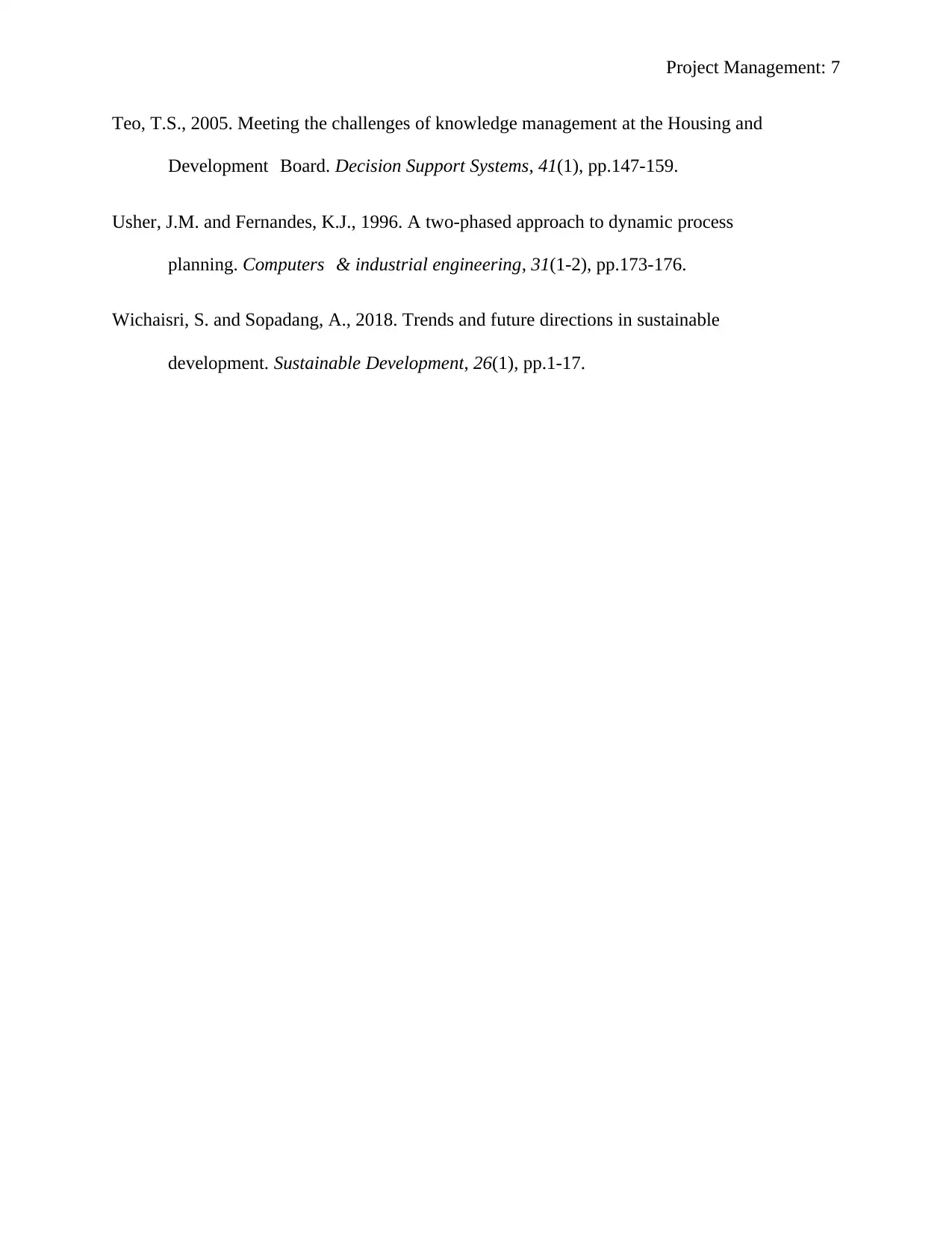
Project Management: 7
Teo, T.S., 2005. Meeting the challenges of knowledge management at the Housing and
Development Board. Decision Support Systems, 41(1), pp.147-159.
Usher, J.M. and Fernandes, K.J., 1996. A two-phased approach to dynamic process
planning. Computers & industrial engineering, 31(1-2), pp.173-176.
Wichaisri, S. and Sopadang, A., 2018. Trends and future directions in sustainable
development. Sustainable Development, 26(1), pp.1-17.
Teo, T.S., 2005. Meeting the challenges of knowledge management at the Housing and
Development Board. Decision Support Systems, 41(1), pp.147-159.
Usher, J.M. and Fernandes, K.J., 1996. A two-phased approach to dynamic process
planning. Computers & industrial engineering, 31(1-2), pp.173-176.
Wichaisri, S. and Sopadang, A., 2018. Trends and future directions in sustainable
development. Sustainable Development, 26(1), pp.1-17.
1 out of 7
Related Documents
Your All-in-One AI-Powered Toolkit for Academic Success.
+13062052269
info@desklib.com
Available 24*7 on WhatsApp / Email
![[object Object]](/_next/static/media/star-bottom.7253800d.svg)
Unlock your academic potential
Copyright © 2020–2025 A2Z Services. All Rights Reserved. Developed and managed by ZUCOL.




